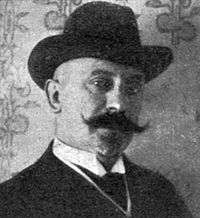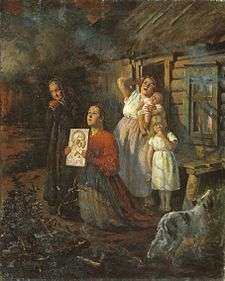Fyodor Buchholz

Fyodor Fyodorovich Buchholz, born Theodore Alexander Ferdinand Buchholz (Russian: Фёдор Фёдорович Бухгольц; 9 June 1857, Włocławek - 7 May 1942, Saint Petersburg) was a Polish-born Russian painter, graphic artist and art teacher of German ancestry. He specialized in genre and historical scenes. Some of his works became popular postcards.
Biography
His father was the owner of a printshop. After graduating from the realschule in his hometown, he enrolled at the Imperial Academy of Fine Arts, where he studied with Pavel Chistyakov and Valery Jacobi.[1] From 1880 to 1882, he was awarded three silver medals. In 1885, he was presented with a gold medal and the title of "Artist" for his rendering of Daedalus and Icarus. After 1888, he participated in the Academy's exhibitions as well as those of the "Society of Russian Watercolorists".

While he was still a student, he began working as a graphic artist: providing illustrations for Niva, North (a literary magazine) and Homeland (a scientific/historical journal). In 1891, he joined the "Association of Russian Illustrators". From 1893 to 1919, he was a teacher a the Imperial Society for the Encouragement of the Arts. In 1902, he won the competition to design the Saint Petersburg Bicentenary medal.[1]
After the Revolution, he was involved in the creation of agitprop and helped design the celebrations for revolutionary holidays. In 1918, he developed sketches for the anniversary celebrations in Petrograd (Saint Petersburg), which included a triumphal arch on Vasilyevsky Island.
In 1924, he became a member of the Association of Artists of Revolutionary Russia and, from 1932, was with the Union of Russian Artists. Between 1919 and 1932, he taught at various secondary schools and Houses of Culture.[1] His wife was Russia's first female sculptor, Maria Dillon.
He died during the Siege of Leningrad and was buried at the Smolensky Lutheran Cemetery.
References
- 1 2 3 Brief biography @ RusArtNet.
External links
![]() Media related to Fyodor Buchholz at Wikimedia Commons
Media related to Fyodor Buchholz at Wikimedia Commons